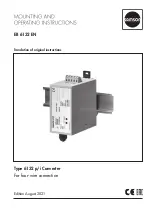
ArbStudio
120
918221
RevA
The
following
fields
are
available:
•
Desired
freq.
[Hz]
‐
Set
the
frequency
of
the
pulse
waveform
from
100mHZ
to
20MHz.
Cannel
frequencies
are
independent
pairs
(1
‐
2
/
3
‐
4
for
1104
ArbStudio
instruments).
Within
the
sample
pair,
the
channel
frequency
is
perfectly
matched
if
one
is
an
even
multiple
of
the
other,
otherwise
the
channel
frequency
might
be
rounded
to
minimize
the
frequency
%
error.
The
rounded
off
frequency
value
is
shown
on
the
Resulting
freq.
[Hz]
field.
•
Period[s]/Frequency[Hz]
‐
Click
the
Period(s)
button
if
you
want
to
define
the
pulse
waveform
by
its
period.
•
Amplitude[V]
‐
Amplitude
of
the
pulse
waveform.
It
refers
to
the
impedance
load,
so
if
the
load
is
50
Ω
the
maximum
amplitude
is
±6V;
if
the
load
is
low
impedance,
the
maximum
amplitude
is
±12V.
•
Rise
Time[%]
‐
Rise
time
percentage
relative
to
the
period
of
the
pulse
waveform.
•
Fall
Time[%]
‐
Fall
time
percentage
relative
to
the
period
of
the
pulse
waveform.
•
Offset[V]
‐
Voltage
offset
of
the
pulse
waveform.
•
Phase[deg]
‐
Phase
of
the
pulse
waveform.
Duty Cycle Modulation Area
This
section
allows
defining
the
modulation
law
of
the
duty
cycle
of
the
pulse
waveform
by
setting
the
modulating
parameters.
The
following
fields
are
available:
•
Desired
freq.
[Hz]
‐
Set
the
frequency
of
the
duty
cycle
modulating
waveform
from
10uHZ
to
6.67MHz
depending
on
the
pulse
waveform
frequency.
If
you
change
the
Frequency
of
the
pulse
waveform,
it
automatically
updates
the
duty
cycle
modulating
waveform
frequency
to
have
the
minimum
%
error
and
also
updates
the
min
‐
max
range.
The
rounded
off
frequency
value
is
shown
on
the
Resulting
freq.
[Hz]
field.
•
Period[s]/Frequency[Hz]
‐
Click
the
Period(s)
button
if
you
want
to
define
the
duty
cycle
modulating
waveform
by
its
period.








































